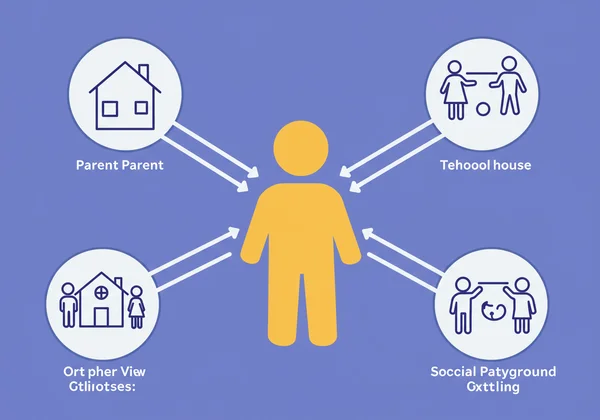Vanderbilt ADHD Assessment: A Parent's Guide to Scores
Watching your child struggle with focus, impulsivity, or staying organized is stressful, and the path to getting answers can feel overwhelming. You may have heard of the Vanderbilt ADHD assessment from a pediatrician or another parent, but what is it, really? Feeling uncertain is completely normal. This guide is here to demystify the Vanderbilt scale, breaking down what the scores mean and how this powerful tool can be your first step toward gaining the clarity you and your child deserve.
Taking that first step is the most important part. You can begin to understand your child's unique attention patterns with a reliable online screening designed to provide clear insights. This journey for answers starts with knowledge, and we are here to guide you through it with empathy and expertise.
What Is the Vanderbilt ADHD Rating Scale?
The Vanderbilt ADHD Rating Scale is one of the most respected and widely used tools for helping to identify signs of Attention-Deficit/Hyperactivity Disorder (ADHD) in children aged 6 to 12. Think of it as a structured conversation starter—a way to gather consistent, objective information about a child's behavior from the people who know them best: parents and teachers. It is not just a random checklist; it's a scientifically designed instrument.
This scale provides a methodical way to look at behaviors related to ADHD. It helps organize your observations into a format that is incredibly useful for healthcare professionals. Instead of just saying "my child can't focus," the Vanderbilt scale helps you pinpoint specific challenges, how often they occur, and how much they impact daily life.

The Science Behind This ADHD Assessment for Children
To build trust, you need to know your tools are reliable. The Vanderbilt scale was developed by the American Academy of Pediatrics and is grounded in the diagnostic criteria for ADHD found in the Diagnostic and Statistical Manual of Mental Disorders, 5th Edition (DSM-5). This means the questions are directly linked to the official standards used by clinicians for making a formal diagnosis.
Its credibility comes from its evidence-based foundation. Researchers have extensively tested the scale to ensure it is a valid and reliable method for screening for ADHD symptoms. When you use a tool like the Vanderbilt scale, you are relying on years of scientific work designed to help children. This is why it is a preferred ADHD assessment for child screenings by pediatricians and psychologists worldwide.
Breaking Down the Parent and Teacher Questionnaires
A key strength of the Vanderbilt assessment is its 360-degree approach. ADHD symptoms don't exist in a vacuum; they can appear differently in various environments. Because of this, the scale includes separate but similar questionnaires for parents (or caregivers) and teachers. This multi-perspective view is critical for a full picture of a child's behavior.
The parent form focuses on behaviors at home and in social settings, while the teacher form provides insight into the child's functioning in the academic environment. Comparing these reports helps determine if the challenging behaviors are consistent across different settings—a key factor in a comprehensive ADHD evaluation. Our user-friendly online version helps you consolidate this information easily.

How to Interpret Your Child's Vanderbilt Assessment Scores
Seeing a set of scores can be intimidating, but understanding them is simpler than you might think. The goal of the Vanderbilt scale is not to label your child but to identify patterns that may warrant further discussion with a professional. The scoring is designed to flag potential areas of concern in a clear, measurable way.
It is essential to remember that these scores are pieces of a much larger puzzle. They are data points that provide insight, not a final verdict. Let's break down what to look for and what it means for your child.

Understanding the Scoring for Inattention and Hyperactivity
The questionnaire asks you to rate specific behaviors on a scale from 0 (Never) to 3 (Very Often). These questions are grouped into categories that align with the core symptoms of ADHD: inattention (e.g., "Fails to give close attention to details") and hyperactivity/impulsivity (e.g., "Fidgets with hands or feet or squirms in seat").
A certain number of questions in each category must be scored as a 2 (Often) or 3 (Very Often) to indicate that the symptom is a potential concern. For example, to meet the criteria for a positive screening on the inattention subscale, a child typically needs to score a 2 or 3 on at least six of the nine inattention-related questions. This threshold-based scoring helps separate occasional childhood behaviors from persistent patterns.
What Does a "Positive Screen" Actually Mean?
It's critical to understand what a 'positive screen' means: it is not an ADHD diagnosis. It is an indicator. It signals that your child is showing a pattern of behaviors consistent with ADHD and that a conversation with a qualified healthcare provider is a strongly recommended next step. Think of it like a smoke detector; it doesn't mean the house is on fire, but it means you absolutely need to check.
Receiving a positive screen can feel scary, but it is actually a powerful step toward getting your child the right support. It validates your concerns and gives you a concrete, evidence-based report to share with a doctor or psychologist. You can take the first step and get a preliminary screening right now to prepare for that conversation.
Looking at Performance and Impairment Questions
Beyond symptoms, the Vanderbilt scale also assesses real-world impact through questions about performance and impairment. These questions ask how the behaviors affect your child's relationships with family and peers, and their performance in academics. A child might be fidgety, but if it doesn't impact their schoolwork or friendships, the clinical significance is different.
This section is vital because it connects symptoms to real-world consequences, which is the cornerstone of any mental health diagnosis. The scores here help a clinician understand the severity of the challenges. Answering these questions honestly helps create a complete picture of your child’s experience.
Vanderbilt vs. Conners': Which ADHD Assessment is Used?
As you research, you may also come across the Conners ADHD assessment. It's another highly respected rating scale, and it's helpful to understand the difference. Both are excellent tools, but they are sometimes used for slightly different purposes.
Knowing about both positions you as an informed advocate for your child. While you don't need to be an expert, understanding the landscape of available tools can make you more confident when speaking with professionals.
Key Differences in Focus and Structure
The Vanderbilt scale is often favored by pediatricians for initial screening because it's efficient, comprehensive, and directly linked to DSM-5 criteria for ADHD. It also screens for co-occurring conditions like anxiety, depression, and oppositional defiant disorder, making it a great all-in-one initial tool.
The Conners scales are often more detailed and can be used for more in-depth evaluations or to monitor treatment progress over time. A psychologist might use a Conners assessment as part of a larger battery of tests following a positive initial screening from a Vanderbilt. For a parent starting this journey, a Vanderbilt-based screening is an ideal and accessible first step. If you're ready to start, our assessment is available now.
Your Next Steps: From Screening Results to Professional Support
Navigating the world of ADHD assessments can be complex, but you've already taken a huge step by seeking out this information. You now understand that the Vanderbilt ADHD Rating Scale is a trusted, science-backed tool that can translate your parental concerns into clear, actionable data. It's not a diagnosis, but a powerful first step on the path to clarity.
The results from a screening can empower you for a more productive conversation with a pediatrician or psychologist. You will walk in with a structured report, not just a list of worries. This is about finding the right support for your child so they can thrive.

Your journey for answers doesn't have to be overwhelming. Our platform provides a reliable, confidential, and user-friendly Vanderbilt-based screening for children. You can get personalized insights that illuminate your child’s attention patterns and receive a comprehensive report to share with a professional. Start your child's assessment today and take that brave, informed next step toward supporting your child's future.
Frequently Asked Questions About Child ADHD Assessments
What is the most accurate ADHD test for a child?
There is no single "most accurate" test for ADHD. A reliable diagnosis comes from a comprehensive evaluation by a qualified professional, which includes clinical interviews, observation, and the use of standardized rating scales like the Vanderbilt. The Vanderbilt scale is considered a highly accurate screening tool for identifying children who should receive such an evaluation.
How do I get a formal ADHD assessment for my child?
The process typically begins with your observations as a parent. The next step is to gather structured information, which is where a tool like our online ADHD assessment comes in. With this report in hand, you should schedule an appointment with your child's pediatrician, a child psychologist, or a psychiatrist, who can then conduct a formal diagnostic evaluation.
Is an online Vanderbilt assessment a formal diagnosis?
No, an online Vanderbilt assessment is a screening tool, not a formal diagnosis. Its purpose is to identify and organize symptoms to determine if a professional evaluation is warranted. A formal diagnosis can only be made by a licensed healthcare professional after a comprehensive clinical assessment. Our tool provides the perfect starting point for that process.
What are the main symptoms of ADHD in children?
The main symptoms of ADHD fall into two categories. Inattention includes difficulty sustaining attention, making careless mistakes, being disorganized, and forgetfulness. Hyperactivity-Impulsivity includes fidgeting, being unable to stay seated, excessive talking, interrupting others, and difficulty waiting for one's turn. A child may show signs of one or both categories.
Disclaimer: This article is for informational purposes only and does not constitute medical advice. It is not a substitute for professional medical advice, diagnosis, or treatment. Always seek the advice of your physician or other qualified health provider with any questions you may have regarding a medical condition.